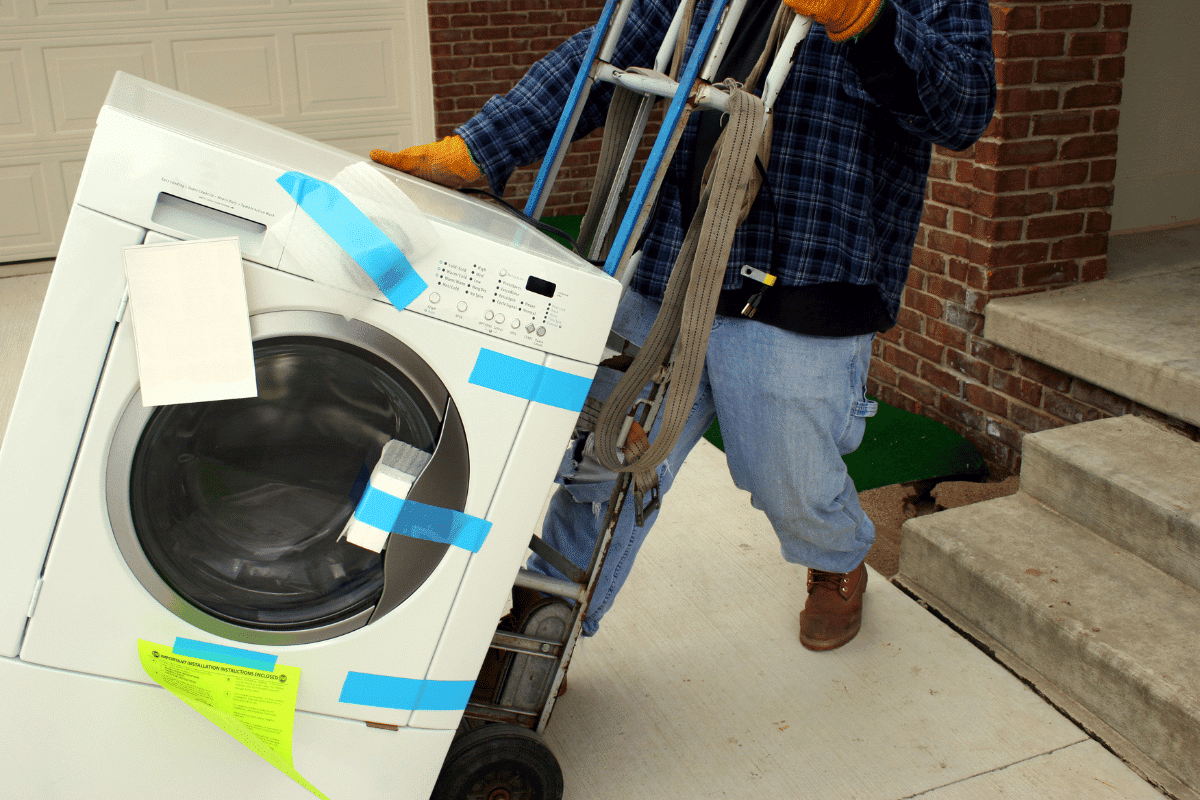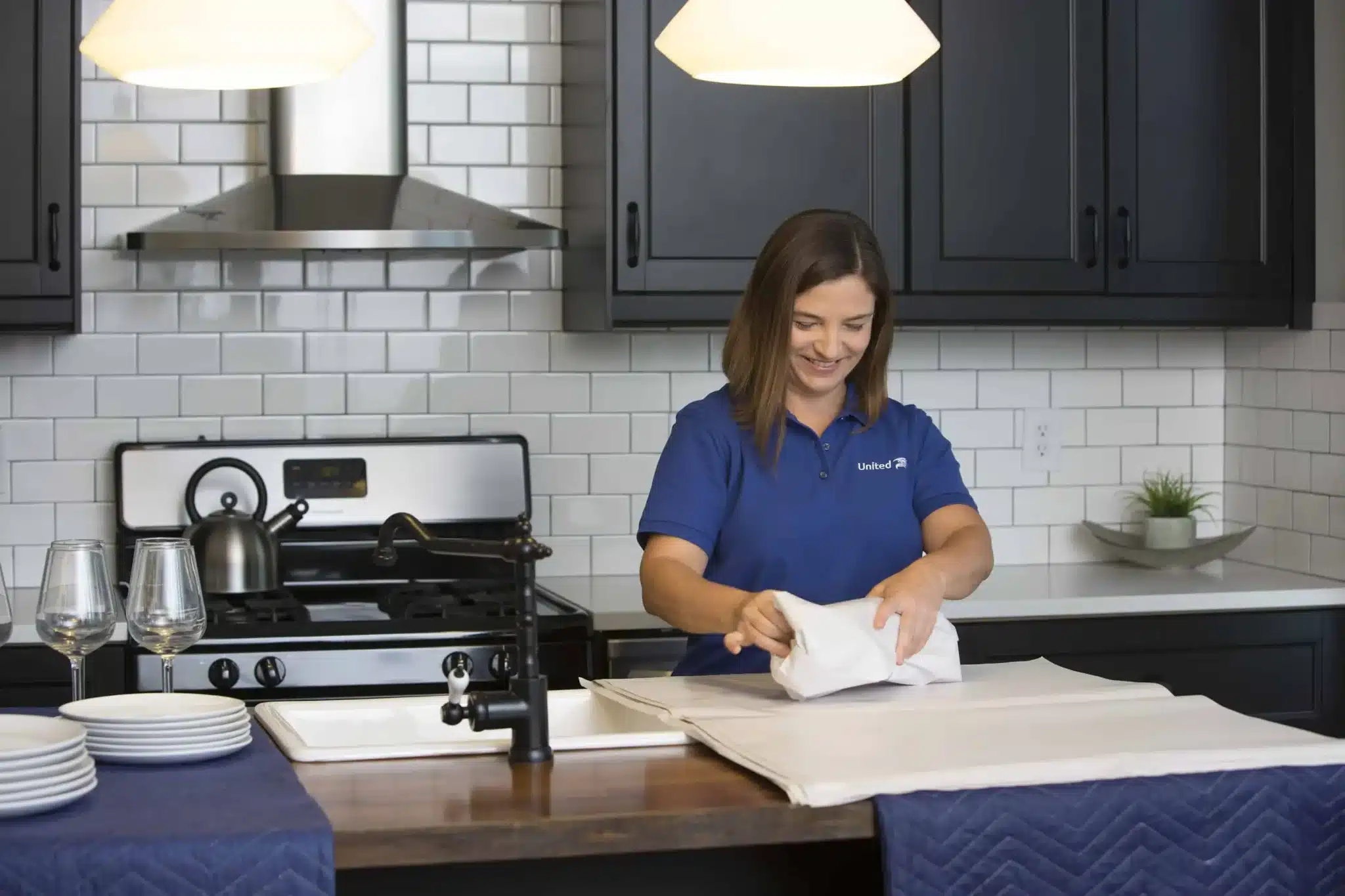Moving house can be an exciting adventure, but it also comes with its challenges, especially when it comes to moving big, heavy items like white goods. White goods are large household appliances such as dishwashers, washing machines, and refrigerators.
These appliances are essential in our daily lives, and taking good care of them during a move is means they’ll work perfectly in your new home for many years after the move. Let’s go through some easy steps to protect your white goods and make sure they arrive safely at your new place.
1. Preparing Your White Goods for the Move

Preparing the Dishwashers
- Run a cleaning cycle to remove any food particles or debris. Once done, dry the interior thoroughly to prevent mold or mildew.
- Turn off the power and water supply to the dishwasher. Carefully disconnect the water inlet and drain hoses. Make sure to drain any remaining water.
- Tape the power cord and hoses to the dishwasher to keep them secure, check this task off on your moving house checklist. Also, secure the racks and spray arms inside to prevent them from moving around.
Preparing the Washing Machines
- Run a hot cycle with a cup of white vinegar to clean the drum and remove any residue.
- Turn off the water supply and unplug the machine. Carefully disconnect the water hoses and drain any remaining water from them.
- Use shipping bolts (usually provided by the manufacturer) to secure the drum in place. This prevents the drum from moving and causing damage while it’s being transported in a hire moving truck.
Preparing the Refrigerators
- Empty the fridge and freezer of all food items. Defrost the freezer at least 24 hours before the move to ensure it’s completely dry.
- Wipe down the interior with a mixture of baking soda and water to remove any odors. Dry it thoroughly.
- Use tape or bungee cords to secure the doors shut. If your fridge has removable shelves and drawers, take them out and pack them separately. Knowing how to move your fridge safely can help you get setup in your new house when it arrives.
2. Packing Your White Goods

Packing Your Dishwasher
- Wrap the dishwasher in thick moving blankets to protect it from scratches and dents.
- If you have the original box, use it. If not, find a sturdy box that fits the dishwasher well. Otherwise using moving blankets to pad around it will be suffice to prevent any scratches and the cords from catching onto anything.
Packing Your Washer and Dryer
- Like the dishwasher, wrap the washing machine in moving blankets. You can also use bubble wrap for extra protection.
- Place the disconnected hoses in a plastic bag and tape them to the side of the washing machine or inside the drum and remember to tape the door so it doesn’t accidentally open up during the move.
Packing your Fridge and Freezer
- Wrap the fridge in moving blankets to protect it from scratches and dents. Secure the blankets with packing tape or stretch wrap.
- Always keep the refrigerator upright during the move. Laying it down can cause damage to the cooling system.
- Make sure you account for doorways when moving your fridge out of the house, sometimes you may need to undo the handles if you encounter tight doorways and corners.
3. Loading and Transporting Your White Goods

Moving Dishwashers, Washers, and Dryers
- These appliances are heavy, so it’s best to have professional removalists move them. Use a dolly or hand truck to make the job easier. Making sure it is strapped onto the dolly tightly.
- Place the dishwasher and washing machine against the truck walls, butted up against the corners and secure them with moving straps to prevent them from moving around during transit.
Moving the Refrigerators
- A refrigerator is bulky and heavy, so use a hand truck or dolly to move it. Strap the fridge securely to the dolly to keep it stable.
- Load the refrigerator last but it needs to be strapped to the truck wall for safety. Doing this the fridge will be the first item off the truck at your new home allowing you to unload and settle for 24 hours before plugging it in.
4. Unpacking and Setting Up in Your New Home

Setup the Dishwasher
- Reconnect the water inlet and drain hoses, ensuring they’re tightly secured. Plug in the power cord and turn on the water supply.
- Double check connections are tight and inspect for any leaks.
- Run a quick cycle to check for any leaks, warning lights and access the balance of the machine to ensure everything is working correctly.
Setup the Washing Machine & Dryer
- Remove the shipping bolts that were securing the drum. Failing this, you can damage your drum and machine. Reconnect the water hoses and plug in the machine.
- Run a short cycle to make sure the washing machine is functioning properly and there are no leaks and that water is getting drained properly.
Setup up the Freezer and Refrigerator
- Before plugging in your fridge and standalone freezer, let it sit upright for at least 4 hours. This allows the oil in the compressor to settle.
- Once the waiting period is over, plug in the refrigerator and set the temperature. Wait a few hours for it to cool down before adding any food.
Expert Tips for Extra Protection
- Invest in high-quality packing materials like bubble wrap, moving blankets, and strong boxes. This extra investment can save you from costly damages.
- Clearly label each appliance and its parts if anything is disassembled. This makes it easier to find everything during unpacking.
- Some appliances have specific moving instructions provided by the manufacturer. Check the user manual or manufacturer’s website for any special steps you need to take.
- If you’re unsure about moving these heavy appliances yourself, consider hiring delivery companies specializing in white goods. They have the experience and equipment to handle your white goods safely.
Conclusion
By following these steps and expert tips, you can protect your dishwashers, washing machines, and refrigerators during your move. Taking the time to prepare, pack, and transport these appliances carefully will ensure they arrive at your new home in perfect condition, ready to serve you for many more years.
Moving your white goods can be a back breaking job but with careful preparation and the right techniques, it is entirely manageable. Ensuring each appliance is properly cleaned, secured, and wrapped before the move will help prevent any damage.
Using appropriate tools like dollies and hand trucks makes the physical lifting easier and safer. Remember to take special care when loading and unloading, and always follow the manufacturer’s guidelines where applicable.
By following these steps, you can minimise the risk of damage and ensure your white goods function smoothly in your new home. If ever in doubt, don’t hesitate to seek assistance from qualified delivery companies who are experienced in handling such heavy and items. Good Luck!
Author Bio
Howe is the visionary behind Find a Mover, a comparison platform that simplifies the process of finding reliable moving companies for consumers. He has been featured on Real Estate Right and regularly shares his insights on top-tier moving industry websites. Connect with him on LinkedIn for more updates.









